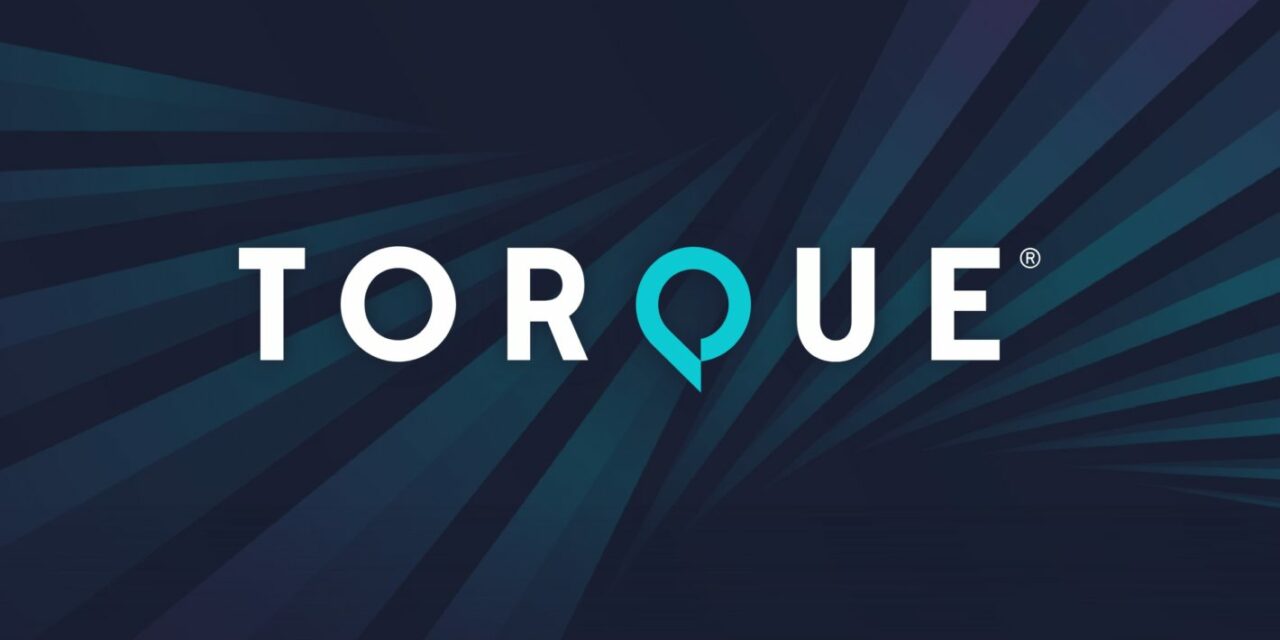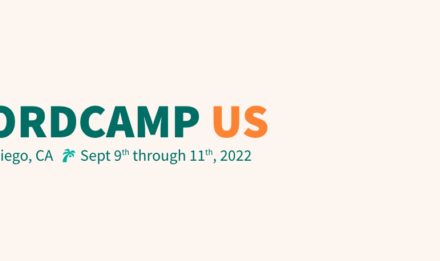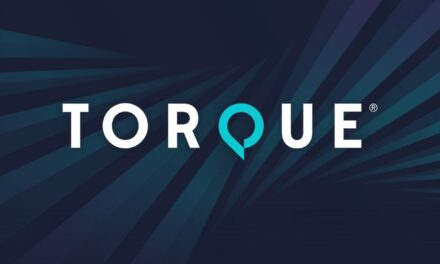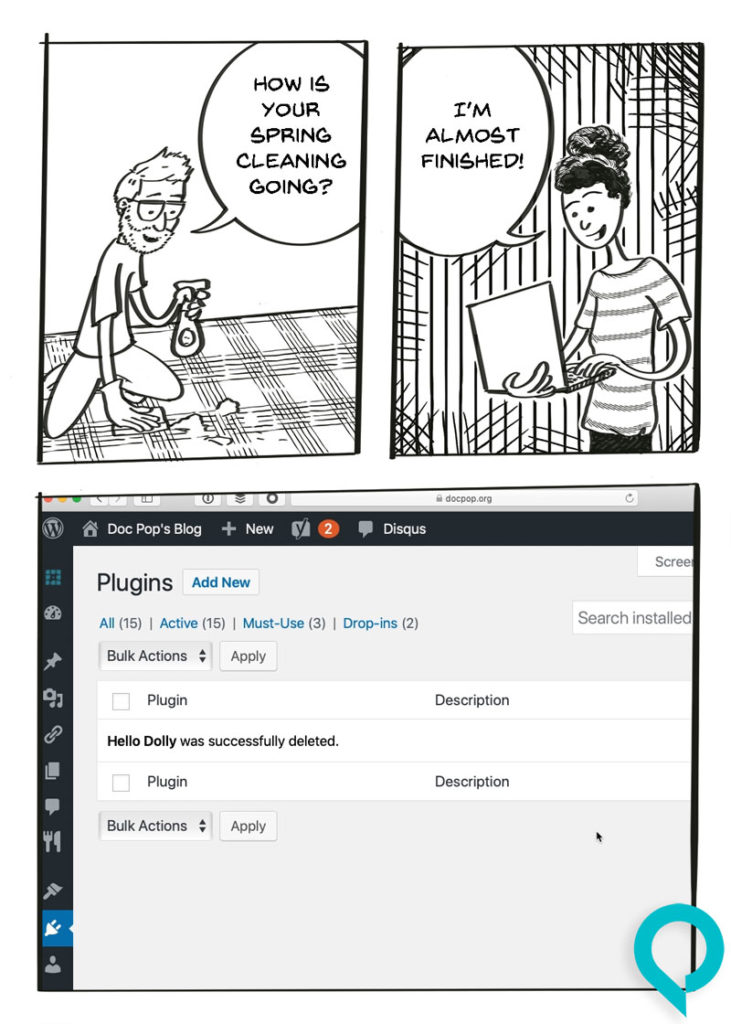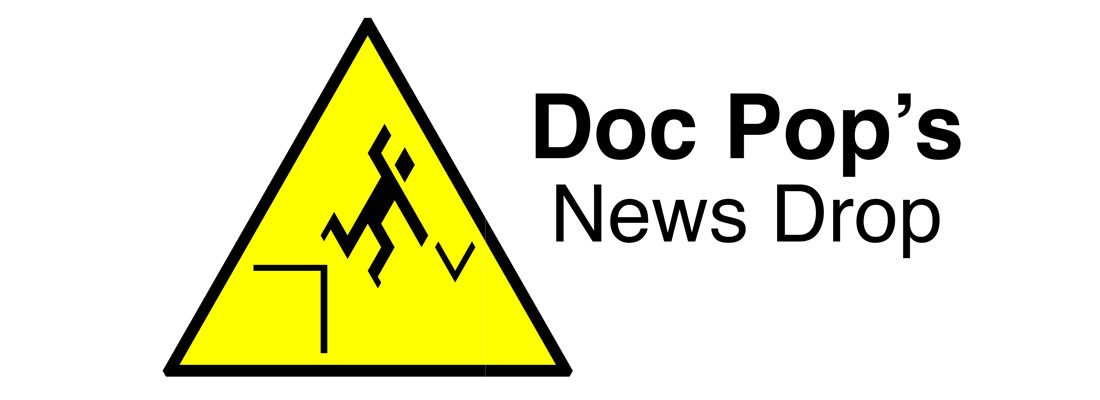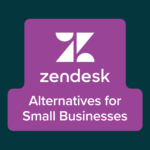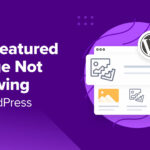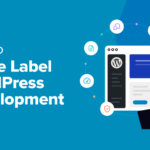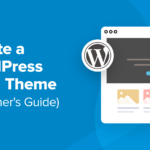Welcome to Press This, the WordPress community podcast from WMR. Each episode features guests from around the community and discussions of the largest issues facing WordPress developers. The following is a transcription of the original recording.
Powered by RedCircle
Doc Pop: You’re listening to Press This, a WordPress Community Podcast on WMR. Each week we spotlight members of the WordPress community. I’m your host, Doc Pop. I support the WordPress community through my role at WP Engine, and my contributions over on TorqueMag.Io where I get to do podcasts and draw cartoons and tutorial videos. Check that out.
WordPress 6.2 was recently released, and it’s a huge update for WordPress, particularly the way the site editor works. With this release, we’re almost at the end of Gutenberg Phase Two, which focused on Full Site Editing through content blocks. So that means that soon WordPress will begin working on Gutenberg Phase Three, which is multi-author Collaboration to talk about the new features in 6.2. And what’s next for Gutenberg, we are joined today by Justin Tadlock, a WordPress Developer relations advocate via Automattic, who is also a release co-manager for Gutenberg 15.4 and 15.5, which just came out today. Congrats to Justin and the team on that.
Justin, let’s get started with just your origin story. How did you get into WordPress?
Justin Tadlock: I was just telling somebody this morning, April 15th this month will be my 20th blogging anniversary. So, blogging for 20 years, but I didn’t start with WordPress until a couple of years later. What I wanted to do was be a writer, I wanna be a novelist one day, hopefully.
But I needed a way to share my work with the world and that’s really how I found WordPress, because I was tired of just putting all my blog posts in one big, giant text file at the time. I needed something to manage it.
And after that I kind of stumbled into the theme design world, and eventually plugin development.
I’m trying to think, after that I started my own business. A theme and plugin business, and I think it was 2007 or 8, around then. I wasn’t great at business, so eventually, I moved on to writing for the WP Tavern at one point, and now I’m over at Automattic, as a developer relations advocate. Just having fun.
Doc Pop: Yeah. That’s awesome. I’m definitely a fan of your writing over on WP Tavern while you were there, and really cool work that you’re doing now with WordPress and with the Gutenberg team. As I said at the beginning of the show, WordPress 6.2 just came out and some folks I was telling this news to, and they were like, “Oh, it’s just a small dot number release. It’s not a big deal.”
But this is one of the larger changes that I’ve seen to WordPress in particular, when you go into the Site Editor, it’s totally different looking. Justin, in your opinion what is maybe the most important new feature in 6.2 for agencies and web developers to know about?
Justin Tadlock: Well, it’s like you said, the Site Editor, like the new design there and we also removed the beta label. So it’s sort of official that, hey, it’s time to work with Site Editor, build block themes. I think we still have a long ways to go in terms of the more advanced features that some developers may need for custom client builds.
But I think 6.2 for me is the release where we can really say it’s time to build block themes.
Doc Pop: Mm-hmm.
Justin Tadlock: And in terms of developer features, I mean, there’s so many neat things to me. The smaller things, like you have box shadow supports for blocks. There’s the custom CSS, which also comes in handy with client work if you need to do some cowboy coding on the fly and add some custom CSS from the editor. Maybe you’re on vacation, you don’t have your full build stack or something. There’s just a ton of smaller updates, fixes. I mean, it’s always continually becoming greater, or the experience is becoming better.
Doc Pop: That custom CSS that you’re talking about, that’s new, I guess. I never touched that aspect, but just the way you kind of mentioned how much easier that is, for a developer to come in and they can add custom CSS to blocks now through the Site Editor, right?
Justin Tadlock: Yes. You can add them on a global level, and you can also add them on the block level too.
Doc Pop: Mm-hmm.
Justin Tadlock: Before we had the additional CSS option within the customizer. So part of this was like bringing feature parity to the site editing experience. So that’s not split up. I knew lots of people used it for quick things. Some people used it for everything. But I do like the idea of putting some CSS for specific blocks because that’s more of an atomic design approach. Right now the management of that is not where I think it should be.
Say you want to change your heading blocks to have a certain line height or whatever it may be. Then you would have to kind of dig into the editor to find that, because there’s no central location for all of your CSS.
Doc Pop: Mm-hmm.
Justin Tadlock: If we can improve that management experience and the next few releases, it’d be one of the best design features in WordPress.
Doc Pop: Absolutely. As just a user, I think one of the things that I first noticed in 6.2 was that new browser mode. Previously you look at a theme and if it was an older style theme, you would use a customizer and now you use the Site Editor. And when you click on a new block-based theme, there’s a whole way to view it.
The way it opens up just feels really sleek and magical. It’s part of the browse mode and it’s just the navigation’s changed. And the thing that really got me, I didn’t see it at first. I kind of had to look around to learn about it. But the style book feature, which is for some reason the icon’s kind of like an open eye.
But when you click on that, now you can go in and see previews of all your blocks as they would appear, and you kind of see them by categories. So it’s all the core blocks and all your third party blocks. You can see how paragraphs will look and you can kind of make changes in this thing. So anytime there’s anything that I’m like, oh, I need to change the way this looks.
I know exactly I need to go to the style book and make my changes there. And it’s super cool that I can also do it with third party stuff, so it makes sense that I can change how my media displays, like do I want rounded edges or gradients or something like that. And it makes sense that I could edit paragraphs there or lists there.
But also my recipe card block for when I share my recipes on how to make Frito pies or something, my calendar widgets. All those things are in there too. And it’s super cool seeing them on the background as they would look on the site. And to be able to tweak them.
I thought visually that was one of the most striking changes in 6.2 and it was super cool.
Justin Tadlock: Yeah, the style book is one of my favorite features from both a user’s viewpoint and a developer standpoint. We’re kinda trying to get away from this at least in theme design, we’re trying to get away from the developer terminology and say creator more. Because you really don’t have to be a developer to be a theme designer anymore.
So let’s say it’s a great user and great creator feature. I know when I’m designing a theme, there’s a lot of like blocks that I don’t really test or use. And so having a quick reference to those via the style book has been a game changer in terms of not having to set up a bunch of demo content for things I don’t really need for a particular design, but wanting to make sure they look correct.
Doc Pop: Justin, I don’t know if you’re on this team or not, but I was talking to Aurooba Ahmed last week and she suggested the style book should have a book icon. And if you have any say over there, I’m hoping maybe they can switch that, open eyeball to maybe like a literal book preview or something, a little icon that maybe explains a little more clearly what that does.
Cause it’s a powerful tool.
Justin Tadlock: Yeah. I think that’s a great idea. I’m not on the design team, but if there’s a ticket, I will definitely highlight it and try to push in any way I can.
Doc Pop: Yes!
Justin Tadlock: because I think a book makes sense there.
Doc Pop: Well, let’s take a quick break and when we come back, we’re gonna continue talking to Justin Tadlock, a WordPress developer who is also a core contributor working on Gutenberg. And he’s gonna tell us about more of the new features that we might have missed on 6.2 and what’s coming in 6.3 and some of his predictions for the future of Pattern Editing.
So stay tuned for more Press This.
Doc Pop: Welcome back to Press This, a WordPress community podcast. I’m your host Doc Pop, and I’m talking to Justin Tadlock, a WordPress Developer Relations Advocate and Core Contributor sponsored by Automattic. We just talked about 6.2, which is a huge release, and I think the next thing we’re gonna start talking about is 6.3.
And I think maybe the starting point for this conversation is, Gutenberg is split up into four phases. Phase Two was full site editing, by using block-based content. And Phase Three is gonna be multi-user collaborative workflows. And it is said that Gutenberg 6.3 is gonna be kind of the end of Phase Two Justin, is that right? We are finally finished with Phase Two and ready to start on Phase Three?
Justin Tadlock: I don’t wanna really use the term finish with the customization phase, which is Phase Two because it feels like that’s final and there will continually be new improvements and future releases to the customization components like the site editor, template editing, style book, global styles.
But officially that phase is ending. And so the big features, hopefully some of those happen in 6.3. We’re kind of in that preliminary like planning Phase Three stage at this point. There’s a post on the make.WordPress.core blog that kind of outlines the early talk about what that might look like.
But much of the work will start duuring the 6.4 release cycle. And that is collaborative editing and much more. The most important thing with that will be real time collaboration. So having two or three people like work at the same time.
We actually talked about this before the show, collaborating via like Google Docs. Especially when you’re working with a team, you all need to come in, make comments, change text without you completely overriding somebody else’s work. One of the most exciting things about collaboration might be the publishing workflow. WordPress is not geared toward say news organizations in any real way. There’s just a kind of a draft status and then publish. There’s no really great flows that go beyond like the basic blogging setup. So I’m really interested in seeing what the community can build with that.
There’s a few great plugins I’m sure that already handle it. But post revisions is going to be a part of that phase. I don’t know what that’s gonna look like. We have a very foundational version of post revision revisions, or we have for years.
Doc Pop: Mm-hmm.
Justin Tadlock: There are probably many ways that can be improved upon. But there’s so much that we can still do.
I’m just excited to see what all the developers in the WordPress community come up with.
Doc Pop: I think you and I both kind of come from like news backgrounds, news site backgrounds, so we instantly think about working with an editor, doing collaboration and needing to do it on Google Docs so that other people can kind of edit with us. But I think what’s missing, or what a lot of people aren’t thinking about is this multi-user collaboration.
Multi-author collaboration isn’t just gonna be in the post editor. The actual site design in theory could be done collaboratively as well. So you could be working with your client and kind of making changes real time, not just a post editor. That’s pretty cool.
Justin Tadlock: I heard somebody awhile back talk about that aspect. Working with a client in real time could save a lot of back and forth. Submitting design mockups and just have them there with you. It’s a really great idea.
Doc Pop: So, is it too early for agencies to start telling their clients about collaboration? If it starts in 6.4, it might not really be something that agencies want to share with their users until near the end of Gutenberg Phase Three, or is it something that’s gonna kind of maybe work from the start?
I’m just kind of predicting here, but I’m wondering if this is something that agencies should already start telling their users about.
Justin Tadlock: I wouldn’t at this point. There’s no roadmap yet, on when a specific feature will land, at least I envision that this would probably start more with the block, like the post editor, rather than site editing. Just like a first revision of it. That’s what I envision anyway.
I don’t know what it would look like. It’s still in the planning phase, you know? So it could be several releases before you’re really talking to clients about what that might look like.
Doc Pop: You mentioned earlier that one of the big things about 6.2 is Gutenberg Phase Two, or the Site Editor is no longer kind of in beta.
So that is a thing probably clients and agencies should be talking about is, “Hey this thing is now polished. It’s ready to go.” So that’s the conversation maybe they should be having is about the Site Editor, if they’re not already using it.
Justin Tadlock: Yeah, it just depends on your client, how much freedom they have with design tools. I know some people like to completely lock down to just content creation for the client. But if you have clients who maybe want to change a few of those things, sure. Have those conversations, introduce them, create learning material around it.
Yeah, I think the site Editor is a great tool, but it can have a huge learning curve for somebody who might be unfamiliar with it. So I think that’s just going to be on an individual like agency basis depending on their specific client.
Doc Pop: Before the show, you and I were talking and you were mentioning some really cool things you’re excited about that didn’t quite make it into 6.2 and will probably be coming out in 6.3 and that kind of final chapter before Gutenberg Phase Three begins.
What are some of those missing features that we’re gonna see in that next release?
Justin Tadlock: Yeah, so one of my favorite features that I’ve been looking forward to is template types that you can add to block patterns as a developer. Say you create a 404 pattern that would specifically be for an error, 404 page. Or maybe you create like three or four different versions of it with different designs, and then you allow the user, when they create their 404 template in the site editor, they can choose between those patterns from the start.
They can just say, add new template 404, and all these registered patterns show up that are specific to that template. The API for that was added in 6.2, I believe.
And right now, when you go to create a new template, it just gives you a fallback and or an empty blank slate to start from. So hopefully in 6.3, at least in Gutenberg 15.5, theme authors can start registering those and having them ready. It can be anything, 404 patterns, single post archive, whatever you want.
They’re specifically tied to the template creation process.
Doc Pop: And that’s that template types feature in the API, which is in 6.2, but the UI isn’t finished yet, but it should be in 6.3.
Justin Tadlock: Yeah.
Doc Pop: Well, I think that’s another good spot for us to take our final break here before we come back and continue talking to Justin. I actually would like to hear more about how developers can use these block patterns.
So maybe we’ll talk about that when we come back. Stay tuned for more Press This with Justin Tadlock.
Doc Pop: Welcome back to Press This, a WordPress community podcast. I’m your host Doc Pop, and I’m talking to Justin Tadlock, a WordPress Developer Relations Advocate and a Core Contributor sponsored by Automattic. Justin, it’s been really fun talking to you today. And I know you were just talking about block patterns and how agencies can use them, or how developers can use them.
As a blogger, I’m not using block patterns that often. They just don’t come up that often for me, and I’m kind of looking to understand more about how developers who work with clients could maybe use these patterns.
In interesting ways, cause I guess I’m used to all this work being done upfront to get the site to look good and I’m just not quite grocking the long-term benefits that could come from working with a block pattern. If you were an agency, what would you be telling me as a user about the beauty here?
Justin Tadlock: Yeah, I think patterns are super useful outside of the blogging world for business websites across the board because as a developer or designer, you can create a specific set of starting points.
So let’s say you’re a restaurant and you want to add a specials menu or something on a new page. Your developer can design this pattern, You can just stick it in through the pattern inserter, and then change the content without having to create the layout aspect of that. Which can be complicated if you’re using columns and rows or group or stack blocks or whatever it may be.
So patterns right now are very much starting points for adding an advanced design that you can obviously do with the Block Editor, but that is harder to do for a non-technical user.
I think in the long term, what we’re really missing is once a pattern is inserted and it’s the editor, it’s no longer a pattern, it is just blocks. What we’re missing is the ability to update those patterns from a developer perspective.
For example, I had somebody mention recently that they had a client with 30 landing pages that all each individually had the query loop block that was all in three column grids. And they needed to go in and update every one of those query loop blocks to be four columns. And instead of doing that just in one pattern, they had to do it on the page because they had already been inserted. So there’s no way to update all those instances yet. So we need something that’s in between patterns and say reusable blocks, like a middle ground there.
I think theme shops can really lean on patterns a lot because that’s a big selling point. These are your bullet points. You could build any kind of site. We have patterns for those types of sites.
I think those are the things that you would sell as a theme shop. Now, say you wanna do a pattern set for restaurants, maybe a pattern set for a salon. Are you a wedding site? You could build like one master theme or whatever it may be and sell the extras. Of course I’m not in the theme shop game anymore. So I’d like to see what more and more people who are in that world are going to do with them now.
Doc Pop: I mean, that makes a lot of sense. And as you kind of mentioned, being able to change these patterns later, but having them, you don’t have to go and change each one individually. That’s something you can do in a block pattern that you wouldn’t be able to do with the other customized block. But that is something you could do with a block pattern is go in later and kind of change something and it’ll globally change for previous versions.
Justin Tadlock: Well, that’s the problem right now. That’s the problem that needs to be fixed is the global changing of all the patterns while still maintaining the content that the user may have altered. We’re not quite there yet. A theme authors I’ve talked to, that is one of the big feature requests.
So I’m making sure I’m getting it out there. That everybody who’s ever talked to me about that, I just mentioned it on a podcast.
Doc Pop: I thinkThat’s a great spot for us to wrap up, to learn more about what Justin Tadlock is working on. You can follow him on Twitter @JustinTadlock. Justin, I really appreciate you joining me here today and I appreciate the folks who tuned in and listened.
Doc Pop: Thanks for listening to Press This, a WordPress community podcast on WMR. Once again, my name’s Doc and you can follow my adventures with Torque magazine over on Twitter @thetorquemag or you can go to torquemag.io where we contribute tutorials and videos and interviews like this every day. So check out torquemag.io or follow us on Twitter. You can subscribe to Press This on Red Circle, iTunes, Spotify, or you can download it directly at wmr.fm each week. I’m your host Doctor Popular I support the WordPress community through my role at WP Engine. And I love to spotlight members of the community each and every week on Press This.

